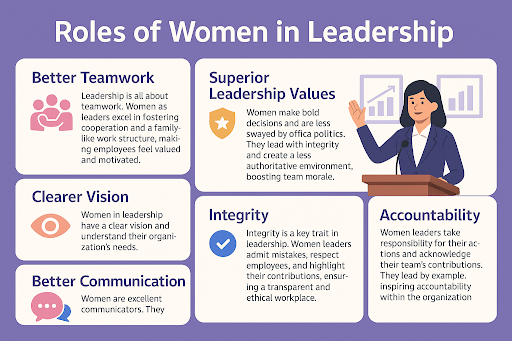Women in Leadership
Wondered where women stand in the board of leadership?
Do you know the number of women in a leadership position?
Or have you ever thought about how many women are in the top paying positions?
Current Statistics
A research by Fortune displayed women are running 23 of the Global 500 leadership positions. Even though this number has shown a great stride from the year 2020 which was 14, it still constitutes about 4.6% of the total number. Thus providing a clear image of how men are leading the charts. Well, if this was not enough, here is something more:
- Women hold only 24% of senior leadership positions globally.
- According to research, roughly 22,000 publicly traded companies around the world, 60% of them have no female board members.
- In 2019, women occupied about the same share of managerial jobs as they had in 1995, at 28%.
- Women make up 45% of the S&P 500 workforce, but only 4% of CEOs.
- Among full-time workers in the United States, women make 79% of what men earn.
- According to a World Bank assessment of businesses, the percentage of female Chief Executive Officers is 18%.
- On average, women earned 76 cents for every dollar earned by men (Urban Institute 2004).
Progress and Challenges
Despite these sobering figures, women are making progress and gaining influence in leadership positions around the world. These figures honor twenty-three of these women, their accomplishments, the values and visions they bring to and execute in their organizations, and the contributions they have made. Despite the challenges and the discriminatory treatment that women have to face in an organizational structure, these women have overcome these obstacles.
The 2015 State of Women-Owned Businesses Report showed that women-owned enterprises have grown 1.5 times faster than the overall increase in new firms. If this is the case, then why not women in leadership positions?
The Early Stages of Women in Leadership
The term "glass ceiling" came into existence in 1986 to describe an impermeable social barrier to women’s advancement in management. It's an invisible barrier that keeps women out of top-level employment simply because they're women, rather than because they lack job-relevant abilities, education, or experience.
Despite early challenges, women rose to leadership positions by overcoming barriers. Many organizations underrepresented them in leadership, and if they did hold positions, they were often undervalued and underpaid compared to men. However, despite these obstacles, women continued to prove their leadership capabilities.

Roles of Women in Leadership
Better Teamwork
Leadership is all about teamwork. Women as leaders excel in fostering cooperation and a family-like work structure, making employees feel valued and motivated.
Superior Leadership Values
Women make bold decisions and are less swayed by office politics. They lead with integrity and create a less authoritative environment, boosting team morale.
Clearer Vision
Women in leadership have a clear vision and understand their organization's needs. They lead by example and align team goals with company objectives.
Better Communication
Women are excellent communicators. They listen carefully and value team input, fostering an open dialogue and constructive feedback culture.
Integrity
Integrity is a key trait in leadership. Women leaders admit mistakes, respect employees, and highlight their contributions, ensuring a transparent and ethical workplace.
Accountability
Women leaders take responsibility for their actions and acknowledge their team’s contributions. They lead by example, inspiring accountability within the organization.
Conclusion
Women today are unstoppable. They are breaking barriers and making a real impact in society. Coco Chanel revolutionized fashion, Kamala Harris shattered political norms, and Ellen Johnson Sirleaf made history as Africa’s first female elected president. These women prove that leadership has no gender.
Frequently Asked Questions
What challenges do women face in leadership?
Biases, underconfidence, and work-life balance issues, addressable via coaching.
How does coaching empower women leaders?
It builds self-awareness, confidence, and strategies for leadership challenges.
What role does xMonks play?
xMonks offers ICF-accredited programs tailored to women’s leadership needs.
Can coaching address workplace biases?
Yes, it equips women to navigate biases and build resilient leadership styles.
Who benefits from leadership coaching for women?
Aspiring/current women leaders and professionals aiming to advance.




.png)